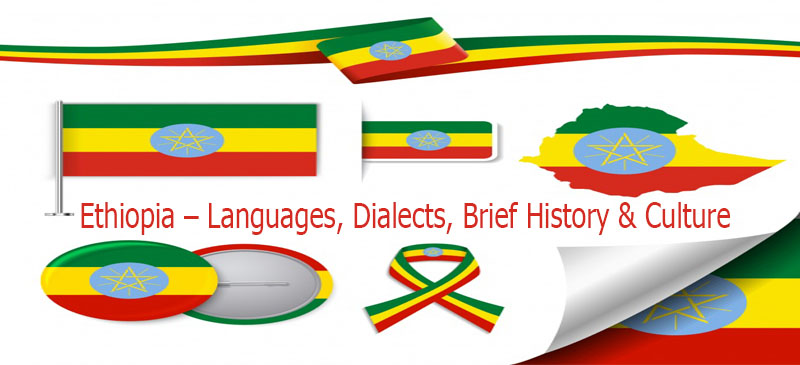Languages spoken in Ethiopia add up to 86, and most of them have Afroasiatic roots. That means they are either Omotic, Cushitic or Semitic, but in regions dominated by the Nilotic tribes, the most spoken tongues are Nilo-Saharan like Komuz and Berta.
On the other hand, the most extensively used foreign language is English. In learning institutions right from primary schools to the universities, it is the most preferred mode of instructions. The official language is Amharic, and it was up to a point in the 1970s the sole medium of instruction for primary schools.
Presently though, that has been replaced by other local dialects like the Tigrinya and the Oromo. However, the widespread use of English coupled with the official stature of Amharic still makes Amharic English Translator services an important means of facilitating efficient communication in many parts of the country.
The Roots of the Ethiopian Civilization and Culture
The roots of what is known as the Ethiopian civilization goes back some 3500 years ago. Originally, much of the civilization was tied to the ancient Egyptian culture. The country occupies part of what in ancient times was known as the Kingdom of Kush, and most of its political evolution revolved around dynasties and kingdoms.
What is now known as the Federal Republic of Ethiopia first emerged as an Empire under the Aksumites.Through imperial reforms and expansions, the empire absorbed people of many nationalities such as Tigray, Amhara, Oromos, Somalis, Afars, Harari, Sidama,Agaw, Gurage, and many others.
Eventually, it became Abyssinia. It was a prominent power in the Horn of Africa from the Zagwe through the Solomonic dynasties. No wonder, a lot of what forms the basis of contemporary Christianity has strong Ethiopian ties. Isn’t believed that Amharic was the popular language used during the time of Jesus? And isn’t a fact that the ancient scrolls containing the original Biblical scripts were written in Amharic? You can know more of such interesting histories if you learn Amharic online.
Other Important Facts About the History of Ethiopia
Other than strong historical links with ancient Christianity, here are some fascinating facts about Ethiopia:
- Despite vain attempts by the Italians who just briefly succeeded in occupying Ethiopia, it is the only African country that was never fully colonized.
- The worldwide Rastafarian movement believes Ethiopia is sacred, and its former emperor, Haile Selassie, was the incarnation of Jesus Christ.
- The world’s most favorite drink, coffee, was first discovered and tasted by a shepherd in a region called Kaffa.
- No other country in the world except Ethiopia boasts a thirteen-month calenda year. All the months end in 30 days with the 13th having only 5 or 6 days.
Ethiopian Culture & Social Conventions
Almost every aspect of Ethiopian society is permeated by religion. The dominant form of worship is Orthodox Christianity, but alongside that other forms of religion like Islam, traditional religions, and Protestantism are practiced.
Some churches are not open to everyone. Women are restricted from entering certain churches or monasteries that are the preserve of men only. So, visiting female tourists had better watch out lest they commit a religious sacrilege!
The society is conservative and places a lot of emphasis on social codes that reinforce traditional norms and values.Apart from the massive pride the people take in their history and identity, Ethiopians are a very sociable people. They love showing affection through kissing and arm-holding.
Hands are an important indicator of etiquette. For performing ablutions,only the left hand is used. It is therefore considered dirty and should not be used for holding food or drink. Even passing things using it is regarded to be offensive. If one happens to be a visitor there, they’d better take care to observe this rule.
Greetings are formal, courteous and are never hurried. Men are expected to hang back and wait for women to proffer their hand.
Language Policies and Quest for Ethnic Dominance
Since the early days of Menelik II through the reign of Mengistu to the present times, Ethiopia has never had a consistent language policy. Whatever has existed in terms of language officialization has often differed from time to time and depended on politics and policy orientation of the government in place.
For instance, the introduction of the Federal Constitution divided Ethiopia into 11 ethno-linguistic regions. Every region reserved the autonomy of developing its own culture and language, and out of that only the Somali, Tigrigna Afaan Oromo, and Amharic grew to be key regional languages. A lot of the ethnic nationalism currently plunging this country into political turmoil and fierce quest for ethnic dominance is a direct outcome of the policy.
However, attempts have been made to standardize some languages like the Oromo, Wolayta, Sidima, and Somali. Despite that, the prevailing lingua franca is Amharic, and that is whyAmharic interpreter for courts officially preside over communications in all litigation processes.

